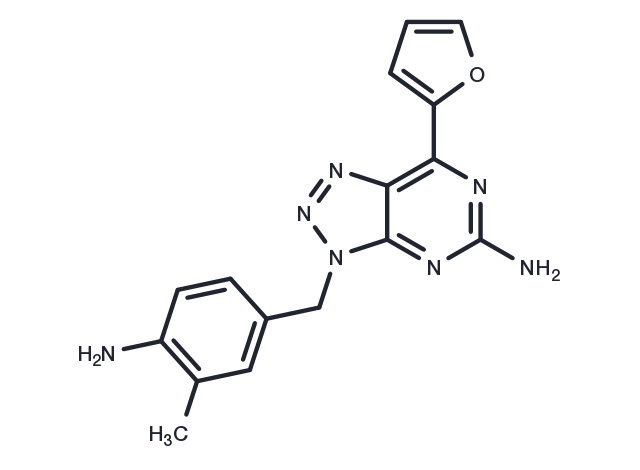Powder: -20°C for 3 years | In solvent: -80°C for 1 year


Vipadenant (CEB-4520)(BIIB-014) is an adenosine A2a antagonist with Ki of 1.3 nM; less potent for A1(Ki=69 nM).

| Pack Size | Availability | Price/USD | Quantity |
|---|---|---|---|
| 1 mg | In stock | $ 34.00 | |
| 2 mg | In stock | $ 48.00 | |
| 5 mg | In stock | $ 79.00 | |
| 10 mg | In stock | $ 122.00 | |
| 25 mg | In stock | $ 222.00 | |
| 50 mg | In stock | $ 369.00 | |
| 100 mg | In stock | $ 549.00 | |
| 500 mg | In stock | $ 1,190.00 | |
| 1 mL * 10 mM (in DMSO) | In stock | $ 378.00 |




| Description | Vipadenant (CEB-4520)(BIIB-014) is an adenosine A2a antagonist with Ki of 1.3 nM; less potent for A1(Ki=69 nM). |
| Targets&IC50 | A1:69 nM(Ki), A2A:1.3 nM(Ki) |
| In vivo | Vipadenant, administered at doses ranging from 0.3 to 30 mg/kg, effectively reduces catalepsy in a dose-dependent manner without inducing statistically significant dyskinetic episodes in 6-OHDA-lesioned rats at a dosage of 10 mg/kg through a 19-day treatment protocol. Moreover, in models of haloperidol-induced hypolocomotion in mice and rats, the minimum effective doses of vipadenant are 0.1 mg/kg and 1 mg/kg, respectively. Additionally, oral administration of vipadenant at 3 and 10 mg/kg is shown to increase contralateral rotations in 6-OHDA lesioned rats, indicating its potential in modulating motor functions. |
| Kinase Assay | Peptide substrate phosphorylation assays with GST-Abl kinase domains: The effect of AP24534 (0-320 nM) on GST-Abl kinase activity is assessed by using a synthetic peptide substrate (Abltide: EAIYAAPFAKKK). Assays are carried out at 30 °C for 15 min in 25 μL reaction mixture: 8 mM MOPS (pH 7), 0.2 mM EDTA, 50 μM Abltide, 30 mM MgCl2, 10 mM β-glycerol phosphate, 1 mM EGTA, 0.002% Brij-35, 0.4 mM DTT, 0.2 mg/mL BSA, 0.4 mM sodium orthovanadate, 10 nM WT or mutant GST-Abl kinase, and 100 μM ATP/γ-32[P]ATP (5000 cpm/pmol). Reactions are terminated by transferring a portion of the reaction mixture onto a p81 phosphocellulose filter and immersing in 0.75% phosphoric acid. Filters are washed 3 times in 0.75% phosphoric acid, rinsed in acetone, and air dried; phosphate incorporation is determined by scintillation counting. All results are corrected for background binding to the filters, as determined by omitting peptide substrate from the kinase reaction. Time course experiments to establish the linear range of enzymatic activity precedes kinase assays. |
| Synonyms | CEB-4520, BIIB-014 |
| Molecular Weight | 321.34 |
| Formula | C16H15N7O |
| CAS No. | 442908-10-3 |
Powder: -20°C for 3 years | In solvent: -80°C for 1 year
DMSO: 31 mg/mL
You can also refer to dose conversion for different animals. More
bottom
Please see Inhibitor Handling Instructions for more frequently ask questions. Topics include: how to prepare stock solutions, how to store products, and cautions on cell-based assays & animal experiments, etc.
Vipadenant 442908-10-3 GPCR/G Protein Neuroscience Adenosine Receptor CEB4520 BIIB 014 BIIB014 inhibit CEB 4520 Inhibitor P1 receptor CEB-4520 BIIB-014 inhibitor
